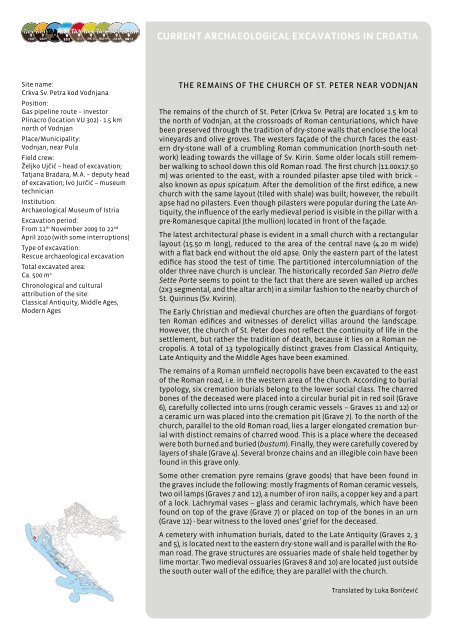AMZ_TAIUH_2017_ prijevodi na engleski
You also want an ePaper? Increase the reach of your titles
YUMPU automatically turns print PDFs into web optimized ePapers that Google loves.
CURRENT ARCHAEOLOGICAL EXCAVATIONS IN CROATIA<br />
Site <strong>na</strong>me:<br />
Crkva Sv. Petra kod Vodnja<strong>na</strong><br />
Position:<br />
Gas pipeline route – investor<br />
Pli<strong>na</strong>cro (location VU 302) - 1.5 km<br />
north of Vodnjan<br />
Place/Municipality:<br />
Vodnjan, near Pula<br />
Field crew:<br />
Željko Ujčić – head of excavation;<br />
Tatja<strong>na</strong> Bradara, M.A. – deputy head<br />
of excavation; Ivo Jurčić – museum<br />
technician<br />
Institution:<br />
Archaeological Museum of Istria<br />
Excavation period:<br />
From 11 th November 2009 to 22 nd<br />
April 2010 (with some interruptions)<br />
Type of excavation:<br />
Rescue archaeological excavation<br />
Total excavated area:<br />
Ca. 500 m 2<br />
Chronological and cultural<br />
attribution of the site:<br />
Classical Antiquity, Middle Ages,<br />
Modern Ages<br />
THE REMAINS OF THE CHURCH OF ST. PETER NEAR VODNJAN<br />
The remains of the church of St. Peter (Crkva Sv. Petra) are located 1.5 km to<br />
the north of Vodnjan, at the crossroads of Roman centuriations, which have<br />
been preserved through the tradition of dry-stone walls that enclose the local<br />
vineyards and olive groves. The westers façade of the church faces the eastern<br />
dry-stone wall of a crumbling Roman communication (north-south network)<br />
leading towards the village of Sv. Kirin. Some older locals still remember<br />
walking to school down this old Roman road. The first church (11.00x17.50<br />
m) was oriented to the east, with a rounded pilaster apse tiled with brick –<br />
also known as opus spicatum. After the demolition of the first edifice, a new<br />
church with the same layout (tiled with shale) was built; however, the rebuilt<br />
apse had no pilasters. Even though pilasters were popular during the Late Antiquity,<br />
the influence of the early medieval period is visible in the pillar with a<br />
pre-Romanesque capital (the mullion) located in front of the façade.<br />
The latest architectural phase is evident in a small church with a rectangular<br />
layout (15.50 m long), reduced to the area of the central <strong>na</strong>ve (4.20 m wide)<br />
with a flat back end without the old apse. Only the eastern part of the latest<br />
edifice has stood the test of time. The partitioned intercolumniation of the<br />
older three <strong>na</strong>ve church is unclear. The historically recorded San Pietro delle<br />
Sette Porte seems to point to the fact that there are seven walled up arches<br />
(2x3 segmental, and the altar arch) in a similar fashion to the nearby church of<br />
St. Quirinus (Sv. Kvirin).<br />
The Early Christian and medieval churches are often the guardians of forgotten<br />
Roman edifices and witnesses of derelict villas around the landscape.<br />
However, the church of St. Peter does not reflect the continuity of life in the<br />
settlement, but rather the tradition of death, because it lies on a Roman necropolis.<br />
A total of 13 typologically distinct graves from Classical Antiquity,<br />
Late Antiquity and the Middle Ages have been examined.<br />
The remains of a Roman urnfield necropolis have been excavated to the east<br />
of the Roman road, i.e. in the western area of the church. According to burial<br />
typology, six cremation burials belong to the lower social class. The charred<br />
bones of the deceased were placed into a circular burial pit in red soil (Grave<br />
6), carefully collected into urns (rough ceramic vessels – Graves 11 and 12) or<br />
a ceramic urn was placed into the cremation pit (Grave 7). To the north of the<br />
church, parallel to the old Roman road, lies a larger elongated cremation burial<br />
with distinct remains of charred wood. This is a place where the deceased<br />
were both burned and buried (bustum). Fi<strong>na</strong>lly, they were carefully covered by<br />
layers of shale (Grave 4). Several bronze chains and an illegible coin have been<br />
found in this grave only.<br />
Some other cremation pyre remains (grave goods) that have been found in<br />
the graves include the following: mostly fragments of Roman ceramic vessels,<br />
two oil lamps (Graves 7 and 12), a number of iron <strong>na</strong>ils, a copper key and a part<br />
of a lock. Lachrymal vases – glass and ceramic lachrymals, which have been<br />
found on top of the grave (Grave 7) or placed on top of the bones in an urn<br />
(Grave 12) - bear witness to the loved ones’ grief for the deceased.<br />
A cemetery with inhumation burials, dated to the Late Antiquity (Graves 2, 3<br />
and 5), is located next to the eastern dry-stone wall and is parallel with the Roman<br />
road. The grave structures are ossuaries made of shale held together by<br />
lime mortar. Two medieval ossuaries (Graves 8 and 10) are located just outside<br />
the south outer wall of the edifice; they are parallel with the church.<br />
Translated by Luka Boričević


